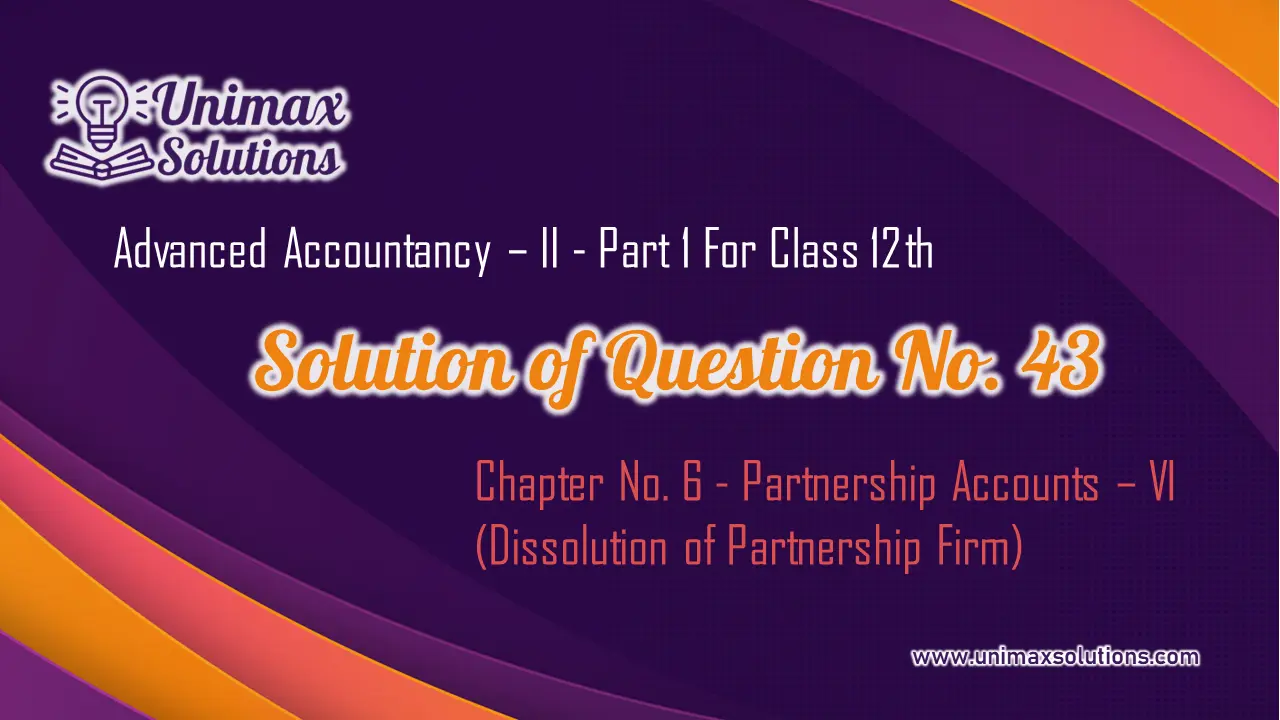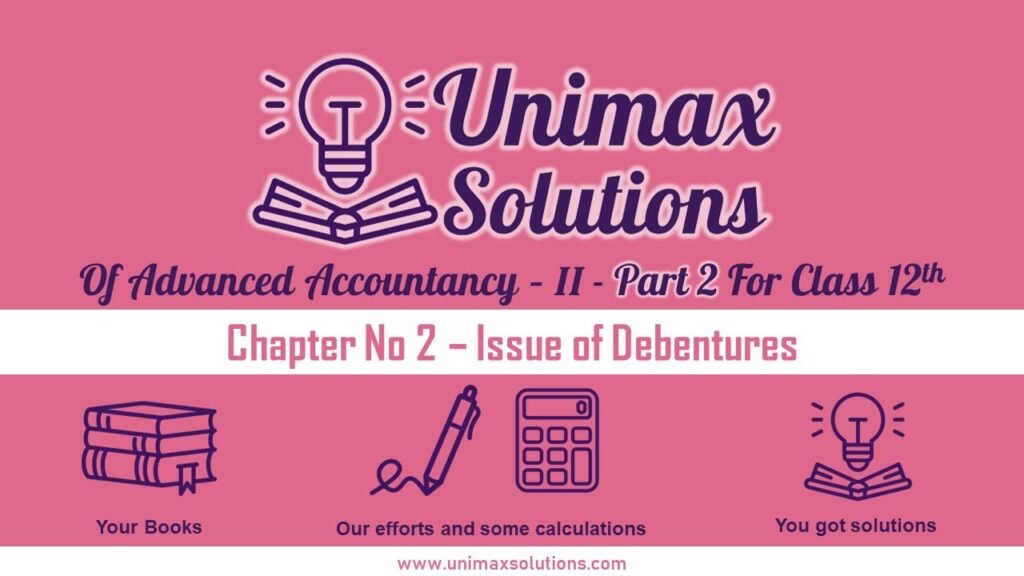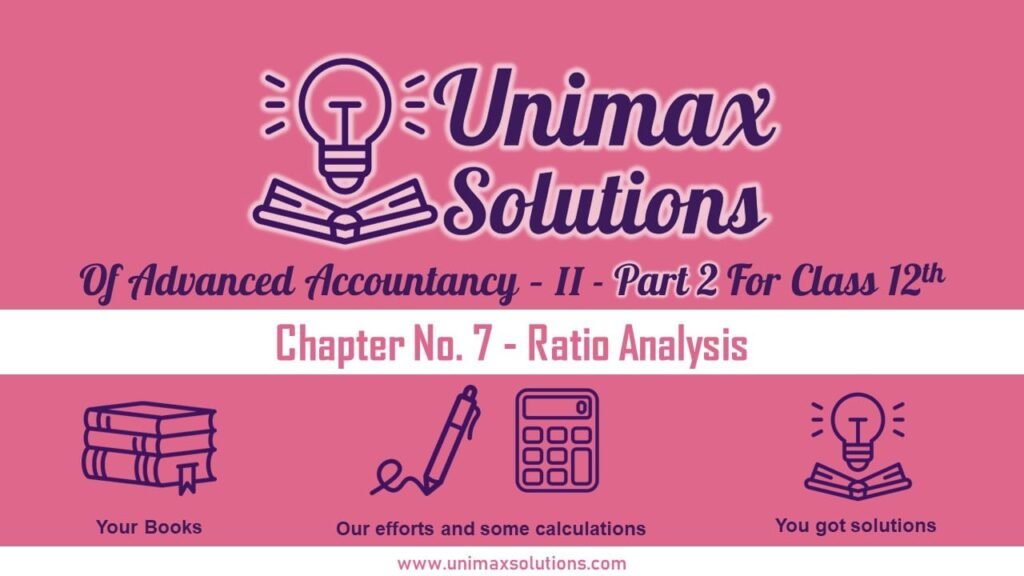Advertisement

Get Solutions to all your practical problems
“Advanced Accountancy” by Unimax, is an invaluable resource designed specifically for students studying accountancy in Classes 11th and 12th under Punjab State Education Board. This comprehensive book equips learners with the necessary knowledge and skills to understand and excel in the subject. In addition to providing a solid foundation in accountancy, the book incorporates advanced concepts to challenge and stimulate students, preparing them for higher education or professional pursuits in finance.
Solutions of Advanced Accountancy by Unimax for Classes 11th and 12th
We have solved the following three books of Advanced Accountancy by Unimax for Classes 11 and 12. These books are covered by the syllabus provided by the Punjab School Education Board(PSEB)
- Advanced Accountancy I Class 11 – Solution
- Advanced Accountancy II Part 1 Class 12 – Solution
- Advanced Accountancy II Part 2 Class 12 – Solution
Check out the Latest 10 Solved Practical Questions:
Below you can find out the chapter-wise full books’ solutions:
1. Solution of Advanced Accountancy II Part 1 Class 12 by Unimax:

The Chapter-wise Solution of Advanced Accountancy II Part 1 Class 12 by Unimax is shown below:

This chapter explores the accounting aspects of non-profit organizations, focusing on their unique characteristics and objectives. It begins by defining non-profit organizations and highlighting the key distinctions between these entities and profit-oriented businesses. The chapter then delves into the specific accounting principles and procedures applicable to non-profit organizations. Topics covered include receipt and payment accounts, income and expenditure accounts, the preparation of balance sheets, and the treatment of items such as subscriptions, donations, legacies, and endowments. Through the use of practical examples and illustrations, students gain a clear understanding of the accounting methods employed by non-profit organizations.
Chapter No. 2 – Partnership Accounts – I (Basic Concepts)
In this chapter, the fundamental concepts and terminology associated with partnerships are introduced to lay the groundwork for partnership accounting. It commences by defining what constitutes a partnership and outlining its distinguishing features compared to other business structures. The chapter covers various aspects including partnership deeds, partnership agreements, and the rights, duties, and responsibilities of partners. Additionally, it provides an overview of different partner types, such as active, sleeping, nominal, and partner by estoppel. Furthermore, the chapter discusses the methods employed for profit distribution among partners, such as fixed ratio, fluctuating ratio, and interest on capital. Practical examples and illustrations are incorporated to facilitate a comprehensive understanding of the foundational concepts.
Advertisement
This Chapter centers around the concept of goodwill in partnership accounting. It begins by elucidating the significance and meaning of goodwill within a partnership firm. The chapter covers topics such as the factors influencing goodwill value, methods of goodwill calculation (average profit method, super profit method, and capitalization method), and the treatment of goodwill in various scenarios, such as the admission, retirement, or death of a partner. Moreover, the chapter discusses the relevant accounting entries about the valuation and treatment of goodwill. To enhance comprehension, practical examples, and case studies are included to illustrate the computation and accounting treatment of goodwill in different contexts.
Chapter No. 4 – Partnership Accounts – III (Change in Profit Sharing Ratio among Existing Partners)
This Chapter concentrates on the accounting aspects related to a change in the profit-sharing ratio among existing partners. It begins by exploring the reasons for altering the profit-sharing ratio and the implications for partners. The chapter covers topics including the adjustment of accumulated profits and losses, revaluation of assets and liabilities, treatment of reserves, and the adjustment of capital accounts. Furthermore, the chapter explains the necessary accounting entries to record the change in the profit-sharing ratio and the resulting adjustments in partners’ capital accounts. Numerous numerical examples and practice questions are provided to enable students to grasp and apply the concepts effectively
This chapter focuses on the accounting treatment involved in admitting a new partner into an existing partnership. The chapter begins by highlighting the reasons and benefits of admitting a new partner and proceeds to cover topics such as methods of admitting a partner, including the gaining ratio and sacrificing ratio, and the determination of the new profit-sharing ratio. Additionally, the chapter discusses the treatment of goodwill, revaluation of assets and liabilities, adjustment of accumulated profits and losses, and the preparation of the new partner’s capital account. Practical examples and case studies are incorporated to enhance understanding of the admission of a new partner and its impact on the partnership’s financial accounts.
Chapter No. 6 – Partnership Accounts – V (Retirement and Death of A Partner)
This Chapter delves into the accounting treatment of the retirement and death of a partner in a partnership firm. The chapter begins by discussing the implications and reasons for a partner’s retirement or death within the partnership structure. It covers topics such as the calculation of the retiring or deceased partner’s share of goodwill, the adjustment of accumulated profits and losses, the revaluation of assets and liabilities, and the distribution of the partner’s capital. Furthermore, the chapter explains the necessary accounting entries to record the retirement or death of a partner and the subsequent adjustments in the remaining partners’ capital accounts. Practical examples and case studies are provided to illustrate the accounting treatment in various scenarios.
This Chapter focuses on the accounting aspects involved in the dissolution of a partnership firm. The chapter begins by explaining the meaning and reasons for the dissolution of a partnership. It covers topics such as the different modes of dissolution, including dissolution by agreement, dissolution with the occurrence of a specific event, and dissolution by court order. The chapter discusses the preparation of the realization account, the treatment of assets, liabilities, and reserves, and the settlement of partners’ capital and loan accounts. Additionally, it explains the necessary accounting entries to record the dissolution and the subsequent distribution of the firm’s assets and liabilities among the partners. Practical examples and case studies are included to enhance understanding of the accounting procedures involved in the dissolution of a partnership firm.
Advertisement
2. Solution of Advanced Accountancy II Part 2 Class 12 by Unimax:
The Chapter-wise Solution of Advanced Accountancy II Part 1 Class 12 by Unimax is shown below:
In this chapter students delve into the topic of Company Accounts, specifically focusing on Share Capital. This chapter introduces students to the concept of share capital and its significance in the functioning of a company. Students will learn about the different types of shares, such as equity shares and preference shares, and the various methods of issuing shares. They will gain insights into the accounting treatment of share capital, including the preparation of share capital accounts, the calculation of calls-in-advance and calls-in-arrears, and the treatment of forfeited shares. By studying comprehensive examples and exercises, this chapter aims to provide students with a thorough understanding of the accounting procedures and calculations related to company accounts and share capital.
Chapter No. 2 – Issue of Debentures:
Chapter 2 of Advanced Accountancy II Part 2 for Class 12 by Unimax focuses on the topic of the Issue of Debentures. This chapter explores the concept of debentures, which are long-term debt instruments issued by companies to raise funds. Students will learn about the various types of debentures, such as redeemable and irredeemable debentures, and the methods of issuing debentures, including at par, at a premium, and at a discount. They will gain insights into the accounting treatment of debentures, including the preparation of debenture redemption reserve, the calculation of interest on debentures, and the redemption of debentures. By studying comprehensive examples and exercises, this chapter aims to equip students with the knowledge and skills necessary to understand the accounting procedures and calculations related to the issue of debentures.
Chapter 3 of Advanced Accountancy II Part 2 for Class 12 by Unimax focuses on the topic of the Redemption of Debentures. This chapter delves into the process of redeeming debentures, which involves repaying the principal amount to the debenture holders. Students will learn about the different methods of redemption, such as redemption at par, premium, and discount, and the accounting treatment involved in each method. They will gain insights into the preparation of the Debenture Redemption Reserve (DRR) account, the calculation of interest on debentures, and the journal entries for the redemption of debentures. By studying comprehensive examples and exercises, this chapter aims to provide students with a thorough understanding of the accounting procedures and calculations related to the redemption of debentures.
Chapter No. 4 – Financial Statements of a Company (Balance Sheet Only):
This Chapter concentrates on the preparation of Financial Statements of a Company, specifically the Balance Sheet. This chapter introduces students to the concept of a balance sheet and its importance in presenting the financial position of a company. Students will learn about the different components of a balance sheet, including assets, liabilities, and shareholders’ equity. They will gain insights into the classification and valuation of assets and liabilities, the preparation of various schedules and notes to the accounts, and the presentation of a balance sheet in the prescribed format. By studying comprehensive examples and exercises, this chapter aims to equip students with the knowledge and skills necessary to understand the preparation and presentation of a company’s balance sheet.
Advertisement
Financial statement analysis plays a vital role in understanding the financial health and performance of a company. It involves the systematic examination of a company’s financial statements, such as the income statement, balance sheet, and cash flow statement, to assess its profitability, liquidity, solvency, and overall financial stability. By utilizing various tools and techniques, such as ratio analysis, trend analysis, and benchmarking, financial statement analysis provides valuable insights into a company’s strengths, weaknesses, and prospects. It helps investors, stakeholders, and management make informed decisions, identify potential risks, and devise strategies for growth and improvement. With its ability to uncover key financial indicators and trends, financial statement analysis serves as a crucial tool for evaluating the performance and financial viability of a company.
Chapter No. 6 – Tools/Methods of Financial Analysis:
Chapter 6 of Advanced Accountancy II Part 2 for Class 12 by Unimax focuses on the Tools/Methods of Financial Analysis. In this chapter, students explore various tools and techniques used to analyze the financial performance and position of a company. Students will learn about key financial ratios and their significance in evaluating a company’s liquidity, profitability, efficiency, and solvency. They will gain insights into ratio analysis, common-size statements, comparative statements, and trend analysis. By studying comprehensive examples and exercises, this chapter aims to provide students with the knowledge and skills necessary to interpret and analyze financial data using different tools and methods.
This Chapter dives deeper into the topic of Ratio Analysis. Building upon the previous chapter, this chapter focuses specifically on ratio analysis as a tool for evaluating a company’s financial performance. Students will learn about different categories of ratios, including liquidity ratios, profitability ratios, activity ratios, and solvency ratios. They will gain insights into the calculation, interpretation, and significance of various ratios, such as the current ratio, gross profit ratio, return on investment (ROI), and debt-equity ratio. By studying comprehensive examples and exercises, this chapter aims to equip students with the knowledge and skills necessary to perform ratio analysis and make informed decisions based on the results.
Chapter No. 8 – Cash Flow Statement:
Chapter 8 of Advanced Accountancy II Part 2 for Class 12 by Unimax focuses on the preparation and analysis of the Cash Flow Statement. This chapter introduces students to the concept and importance of a Cash Flow Statement, which provides information about the cash inflows and outflows of a company during a specific period. Students will learn about the classification of cash flows into operating, investing, and financing activities. They will gain insights into the preparation of a Cash Flow Statement using the direct and indirect methods, as well as the interpretation and analysis of the statement. By studying comprehensive examples and exercises, this chapter aims to provide students with a thorough understanding of the preparation, interpretation, and analysis of the Cash Flow Statement as a vital tool for assessing a company’s liquidity and cash management.
Advertisement





















